
- Homepage
- Brand
- Alkota (77)
- Author Doll (38)
- Bestpysanky (28)
- Buyrussiangifts (47)
- Ceprueb Nocag (21)
- Fedoskino Style (15)
- Firebird (17)
- Firebirdworkshop (33)
- Greatrussiangifts (25)
- Hand Painted (14)
- Handmade (922)
- Handmadfe (53)
- Matryoshka (48)
- Nesting Dolls (35)
- Nestingdollsstore (22)
- Russian (50)
- Russian Nesting Doll (16)
- Semenov (18)
- Sergiev Posad (34)
- Unknown (19)
- ... (4811)
- Doll Size
- Ethnicity
- Sport
- Team
- Type
- Action Figure (7)
- Art Toy (4)
- Artist Doll (5)
- Charm(s) (13)
- Doll (24)
- Dolls (4)
- Fashion (5)
- Figure (4)
- Figurine (6)
- Hand Painted (55)
- Lacquer Box (17)
- Light Sculpture (3)
- Matryoshka Dolls (3)
- Nesting (346)
- Nesting Doll (954)
- Nesting Dolls (15)
- Russian (7)
- Russian Dolls (31)
- Set (6)
- Standard (3)
- ... (4831)
Genuine Russian KOROBEINIKI 8 nesting dolls MATT CHRISTMAS TREE Snowman Mitina
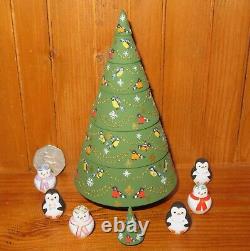

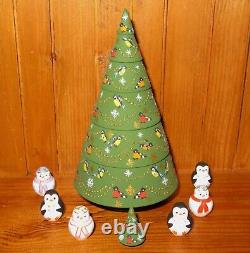
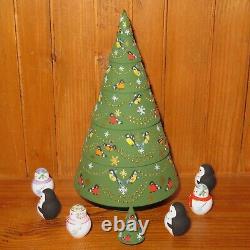
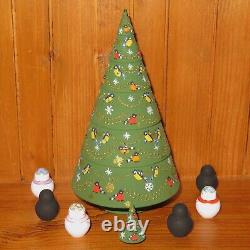
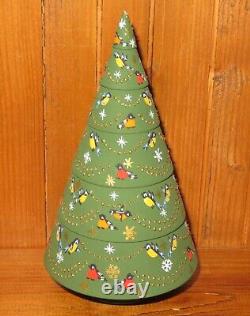

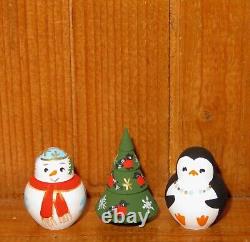
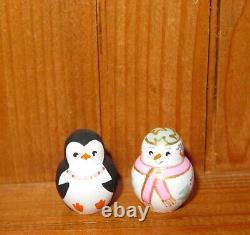



This is a beautiful set of 8 Russian nesting Christmas Tree Dolls made to order by The Russian Artist. Height of the big doll is 14.2 cm (5.59 inches), the little ones are 2.1 cm or 0.82 of an inch tall. Style which means that the biggest doll contains a number of smaller dolls of equal size, in this case 5. Was an ancient symbol of life in the midst of winter.
Romans decorated their houses with evergreen branches during the New Year, and ancient inhabitants of northern Europe cut evergreen trees and planted them in boxes inside their houses in wintertime. Many early Christians were hostile to such practices. The second-century theologian Tertullian condemned those Christians who celebrated the winter festivals, or decorated their houses with laurel boughs in honour of the emperor: Let them over whom the fires of hell are imminent, affix to their posts, laurels doomed presently to burn: to them the testimonies of darkness and the omens of their penalties are suitable.
Are a light of the world, and a tree ever green. If you have renounced temples, make not your own gate a temple.
But by the early Middle Ages, the legend had grown that when Christ was born in the dead of winter, every tree throughout the world miraculously shook off its ice and snow and produced new shoots of green. At the same time, Christian missionaries preaching to Germanic and Slavic peoples were taking a more lenient approach to cultural practices-such as evergreen trees. These missionaries believed that the Incarnation proclaimed Christ's lordship over those natural symbols that had previously been used for the worship of pagan gods.Not only individual human beings, but cultures, symbols, and traditions could be converted. Of course, this did not mean that the worship of pagan gods themselves was tolerated. According to one legend, the eighth-century missionary Boniface, after cutting down an oak tree sacred to the pagan god Thor (and used for human sacrifice), pointed to a nearby fir tree instead as a symbol of the love and mercy of God. Not until the Renaissance are there clear records of trees being used as a symbol of Christmas-beginning in Latvia in 1510 and Strasbourg in 1521. Legend credits the Protestant reformer Martin Luther with inventing the Christmas tree, but the story has little historical basis.
The most likely theory is that Christmas trees started with medieval plays. Dramas depicting biblical themes began as part of the church's worship, but by the late Middle Ages, they had become rowdy, imaginative performances dominated by laypeople and taking place in the open air. The plays celebrating the Nativity were linked to the story of creation-in part because Christmas Eve was also considered the feast day of Adam and Eve.Thus, as part of the play for that day, the Garden of Eden was symbolized by a "paradise tree" hung with fruit. These plays were banned in many places in the 16th century, and people perhaps began to set up "paradise trees" in their homes to compensate for the public celebration they could no longer enjoy. The earliest Christmas trees (or evergreen branches) used in homes were referred to as paradises.
They were often hung with round pastry wafers symbolizing the Eucharist, which developed into the cookie ornaments decorating German Christmas trees today. The custom gained popularity throughout the 17th and 18th centuries, against the protests of some clergy. Lutheran minister Johann von Dannhauer, for instance, complained (like Tertullian) that the symbol distracted people from the true evergreen tree, Jesus Christ. But this did not stop many churches from setting up Christmas trees inside the sanctuary. Alongside the tree often stood wooden "pyramids"-stacks of shelves bearing candles, sometimes one for each family member.
Eventually these pyramids of candles were placed on the tree, the ancestors of our modern Christmas tree lights and ornaments. These sets are truly beautiful works of art, finished all round to the highest standard by one of the very best artists in Russia! If you are looking for a very special set for a special present or for your own collection, this is it. Her work has not just a wonderful fine quality finish but also has a beautiful loving warmth to it. Ll my dolls fit inside one another!!We speak French, English, German and Russian. Please leave feedback once you have received the item so that I know it has arrived safely. I will leave feedback in return. Smoke & Pet Free Item. Powered by SixBit's eCommerce Solution.
But this did not stop many churches from setting up Christmas trees inside the san.
